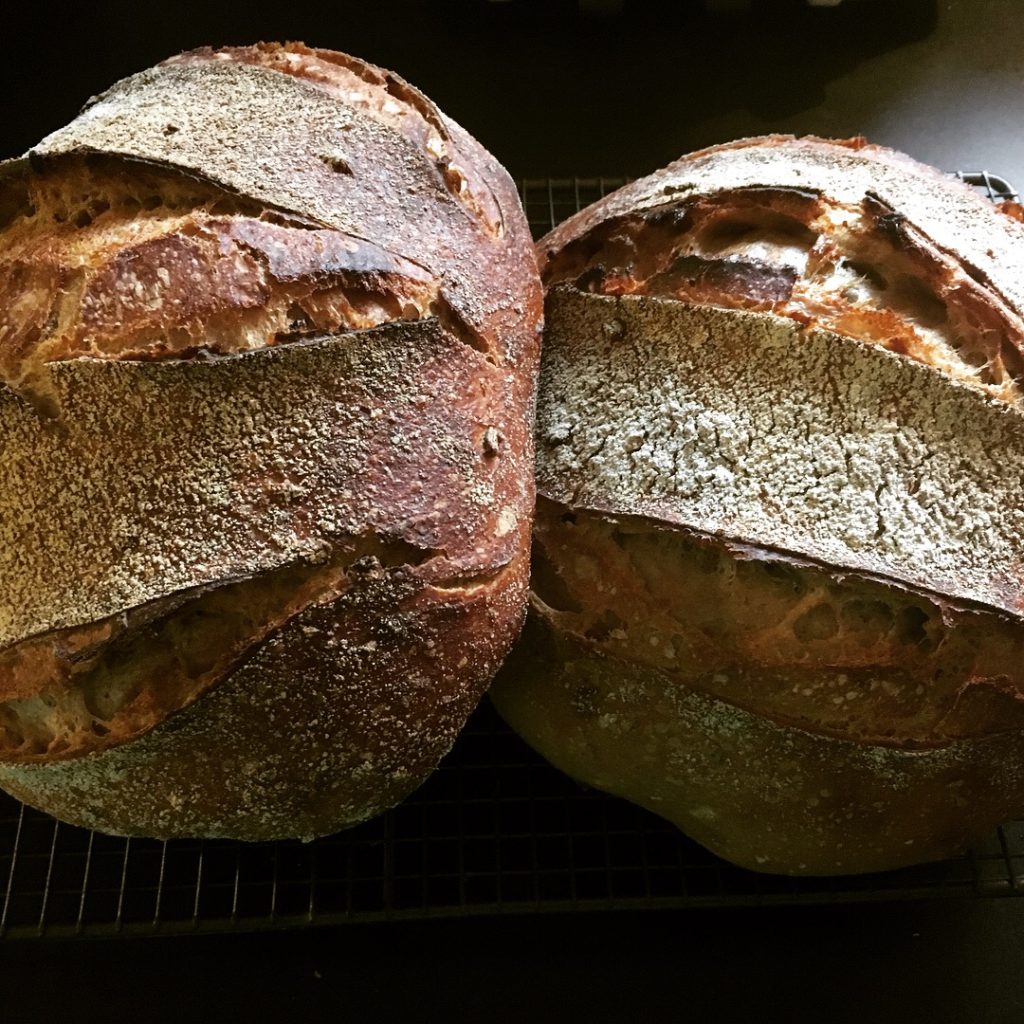

(makes two loaves)
FOR THE LEAVEN
90g bread flour
90g water
FOR THE BREAD
200g leaven
1kg white-bread flour (or any other mix of flour you like)
20g fine sea salt
700-750g water
Make the leaven: The morning before baking, put 1 tablespoon of your mature, bubbling starter in a bowl and add 90g of flour and 90g of 30 c water. Stir well. Cover with a tea towel and let it rest at room temperature for 4-6 hours or until puffed up in appearance. To test for readiness, drop a tablespoon of leaven into a bowl of tepid water; if it floats it’s ready to use.
Make the dough: In a large bowl, measure out 1kg strong bread flour (any combination you wish, but to keep the bread light I use 800g Italian ’00’ flour and 200g rye/malted/spelt flour). Add your leaven (which should be around 200g), then add 700g of warm water (around 36 degrees) and stir to disperse.
Use a spatula and hands to mix until no traces of dry flour remain. The dough will be sticky and ragged. Cover bowl with a towel and let the dough rest for 25 to 40 minutes at room temperature.
Add 20g fine sea salt and up to 50g of warm water, but don’t add the water all at once – massage it into the dough a tablespoon at a time, and stop when the dough feels well hydrated. The ‘right’ feel of the dough will come with practice! Using your hand in the shape of a claw, mix repeatedly in a repetitive clockwise motion for a few minutes.
Cover the dough with a tea towel and make sure it stays warm – between 26 and 28 degrees ideally (near a window in a sunny room is usually a good option). Leave the dough for 30 minutes (use a timer), then fold and stretch it by dipping your hand in water, taking hold of the underside of the dough and stretching it up over the rest. Repeat this action 3 more times, rotating the bowl a quarter turn for each fold. Do this every half an hour for 2 hours, and every hour for another 1.5-2 hours (around 4 hours total, including mixing the leaven and adding the salt). The dough should be tacky and increase in volume by 20 to 30 percent. If not, continue to let rise and fold for up to an hour more.
Transfer the dough to a work surface which has been sprinkled with water. Use a dough scraper to cut the dough into 2 equal pieces and work the dough lightly into taut rounds. You are aiming to create a smooth tension across the top of each piece of dough. Leave the dough rounds on your work surface, dust the tops lightly with flour and cover with a tea towel. Leave them to rest for 30 minutes.
Flour your two banettons liberally with rye flour or similar.
Use a dough scraper to flip the rested dough rounds over onto their floured side. Take the first round, and starting at the side closest to you, pull the bottom 2 corners of the dough toward you (the dough scraper will help if it sticks), then fold them up into the middle third of the dough. Repeat this action on the right and left sides, pulling the edges out and folding them in over the centre. Finally, lift the top corners up and fold down over previous folds. The final fold should push the dough away from you and produce a smooth, taut ball which can then be lifted quickly but carefully into your prepared banetton, seam side up. Repeat with the other round.
Cover with a tea towel (or, better still, an inflated bag which can be used again repeatedly for future bakes). Transfer both banettons to the fridge overnight.
The next morning, about 30 minutes before baking, place a large lidded cast-iron casserole in the oven and heat it to 260 degrees (or as hot as your oven gets). Turn the cold dough out onto a reusable baking sheet – if the banetton is well floured it should come out easily. If it doesn’t this can wreck your bake, so be lavish with your flour next time – lots of flour on the crust is fine; a dough pulled and prodded out of an under-floured banetton is usually a write-off. Use a baker’s blade or sharp serrated knife to score the bread, holding the blade at an angle of 45 degrees and using quick movements.
Carefully remove the heated casserole from the oven and gently lift your baking sheet, with its cargo of proved, scored dough, into the hot pan. Using oven gloves, replace the casserole lid and place the pot back in the oven. Turn down the heat to 240 degrees and cook for 30 minutes. Carefully remove the lid (there will be steam, so be careful) and cook for 10-15 more minutes or until the crust is a rich, caramelised golden brown.
Transfer the bread to a wire rack to cool for at least 15 minutes before slicing.